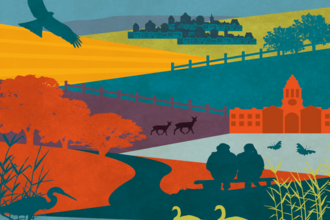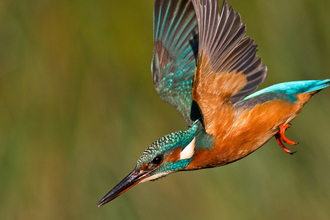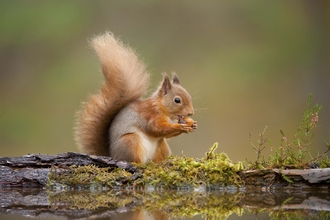Bringing wildlife back
Nature in the UK is broken. We are one of the most nature-depleted countries in the world.
There is still hope – we are able to fix things if we act now, together.
For wildlife to truly begin to recover we need to make space for it – at least 30% of the land and sea across the UK must be protected, connected and managed for nature by 2030. This target is what we’re calling 30 by 30. In Cheshire 30% would be approximately 90,000ha of land. Currently only 5% of land in our region is looked after in this way so there is still a way to go.
We know Cheshire Wildlife Trust simply can’t achieve 30% on our own – we need you to join our wild network. Every nature reserve is important, but so too is people making space for nature on estates, farms, parks, schools, business grounds, road verges, alleyways, gardens and window ledges.
How we’re achieving 30 by 30
Our nature reserves
From our 210-acre Bickley Hall Farm HQ in Malpas, to the coastal home of the natterjack toads on Red Rocks Nature Reserve in Wirral, to Cheshire’s first beaver family in over 400 years in Hatchmere Nature Reserve near Delamere, Cheshire Wildlife Trust protects and manages 30 nature reserves across the region.
We are looking to expand the area of land under our management. Starting with Saltersford Farm Nature Reserve we are strategically trying to find sites that have a low value for wildlife and rewild them. This allows us to make the largest possible net contribution to biodiversity with our work.
See all the sites we manage for wildlife here. While many of our sites are looked after specifically for nature with limited or no public access, we have gathered our favourite nature reserves and wildlife hotspots across the region for a great day out in nature.
Helping others to manage their land
A big part of what we do is working with landowners and farmers to help wildlife across the landscape. For our native plants and animals to thrive and spread, we need bigger, better and more joined up space for wildlife – living landscapes. These ‘highways’ of rivers, hedgerows and gardens allow species to move freely, connecting one wildlife haven to another.
Read more about the habitats we have in Cheshire and the work we’re doing to restore them.
We help landowners, schools and businesses create space for nature through tree and hedgerow planting, meadow creation, pond installation, removing invasive species, flood management initiatives and supporting funding streams.
Find out what you can do to help wildlife, no matter how big or small your space.
Providing land management services
Our team of leading professionals offer a suite of ecology and land management-based services. We have specialisms in ecological consultancy, habitat creation and management, the agricultural environment, Biodiversity Net Gain, neighbourhood planning, carbon offsetting and outdoor learning. As members of the national Wildlife Trust Consultancy, we are capable of supporting clients with projects nationwide, with the benefit of local, county-based expertise. The profit we generate is invested back into conservation here in Cheshire. In short, by employing our services, you’re both directly and indirectly helping conserve our region’s wildlife.
Find out how our services can help make your school, business or land wilder.
You can also visit our dedicated services website for more information.
Saving and reintroducing species
The Living Planet Report 2022, revealed that global wildlife populations have plummeted by 69% on average since 1970. Most of us are familiar with the plight of the rainforest, tigers and pandas, but we have lost species altogether right here in Cheshire. And we’re at risk of losing more if we don’t act.
Did you know:
- The black poplar is the most endangered native timber tree in Britain
- White clawed crayfish are more endangered than the giant panda
- European eels are less common than snow leopards
- Willow tits are the fastest declining bird in the UK.
- All of these species have remnant populations in Cheshire.
In 2013 we started work on returning the white-faced darter dragonfly to Delamere, where it had become locally extinct a decade before. The population has now re-established, and the project is being used as inspiration for similar reintroductions in the north west.
Our work to reintroduce beavers started in 2020 in Hatchmere, with the first pair of beavers to be released in Cheshire for over 400 years. Willow (female) and Rowan (male) have grown into their new home and currently have two kits, named Aspen and Bramble. We are waiting to hear from the Government about the next steps for wild release of beavers. Our landscapes desperately need their engineering prowess to not only recover nature, but to also to restore our broken hydrology. As soon as we can, we want more beavers in our rivers.
Working with partners, we have reintroduced rare plants to our mossland reserves such as lesser skullcap and great sundew which now grows in Cheshire for the first time in over a century.
Cheshire Wildlife Trust has collected more than 200,000 seeds from across Cheshire as part of a national project to protect the UK’s trees. Tree seeds collected as part of the project are banked in the underground vaults of Kew’s Millennium Seed Bank, the largest wild plant seed bank in the world, to form the UK’s first national collection of tree seeds.
Our Dee Estuary is looking to build populations of little terns, grayling butterflies and natterjack toads on the estuary – all species which are under threat.
In the Peak District we are working with partners across borders to secure the future of the curlew and other wader birds which are threatened by agriculture and predation.
Rewilding Stockport is turning the town into an urban nature reserve with hedgehog highways, swift streets and pollinator patches.
Elsewhere in Cheshire, a new project in the River Gowy catchment is looking to set up a water vole hotspot to revitalise populations and provide a hub from where neighbouring populations can be reinforced.
We also have our own plant nursery, where we grow local and native species of wildflowers and trees to bolster local genetics when creating new meadows and woodlands.
Influencing local and national nature policies
New developments can create both threats and opportunities for local wildlife. Working with planning authorities and influencing local, regional and national planning policy is one of the Trust’s most important activities.
The planning system exists to control development, ensuring the right sort positive or favourable development occurs in the right location while preventing inappropriate planning.
Cheshire Wildlife Trust gives wildlife a voice by:
-
Responding to major development and infrastructure projects, strategic planning consultations, such as local Development Frameworks, Local Transport Plans, and Minerals & Waste Plans, to ensure the appropriate policies are in place to protect wildlife.
-
Commenting on planning applications where there is potential for significant negative effects to wildlife or where there are opportunities to secure and create new opportunities for wildlife.
-
Commenting on planning applications in which the proposed developments have the potential to harm or enhance the ecological network of Cheshire Wildlife Trust reserves, Local Wildlife Sites and statutorily protected sites.
-
Responding to developments which threaten habitats and species of conservation importance as listed on the UK Biodiversity Action Plan (BAP) and Cheshire Region BAP.
-
Providing advice to, and consulting with; MPs, Councilors, planners, developers, consultants, members of the public and other key stakeholders.
Major developments in our region include:
You can read our latest planning responses here.
If you think a developer is in breach of planning regulations in a way that threatens wildlife, contact Natural England (Crewe offices 0300 060 2922).
We also offer advice to developers and land management services through our ecological consultancy.
Protect marine wildlife
In Cheshire we have two of the richest marine environments in the region: the Dee and Mersey estuaries. We are working to secure the future for these internationally important habitats and those of the Irish Sea.
A sustainable society and economy needs productive and healthy seas. Yet for many years pollution, unsustainable development and the way we fish have damaged and depleted our seas. Our vision is for Living Seas - where better protection and management of our seas means that species which have declined can become common again.
Living Seas means thriving fish stocks and healthy, recovering marine habitats. It means environmentally sustainable use of our seas' resources. It means ocean processes helping to slow down climate change. It means people valuing the sea for the many ways in which it supports our quality of life.
The Irish Sea covers 45,000km and is 300m deep at its deepest point.
Our seas are suffering from overfishing, exploitation for resources and damage to natural habitats. Marine Protected Areas – parts of the sea where wildlife and habitats are protected – are key to the future health of our seas, their ecosystems and wildlife.
As the North West Living Seas, Cheshire Wildlife Trust, along with Cumbria Wildlife Trust and Lancashire Wildlife Trust are working together to ensure we save a space for our marine life across the Irish Sea.
Our Dee Estuary inspires coastal communities on the Wirral and in Flintshire & Denbighshire about the natural heritage of the Dee Estuary.
The project aims to
-
Make the Dee Estuary a greater part of more people’s lives and a better place to live, work and play.
-
Work with local communities, visitors and partners to ensure our natural heritage is better managed and recorded.
-
Raise awareness of the habitats and wildlife along both sides of the Estuary.
-
Empower local communities to reduce environmental impacts and offer training and life-long learning.
Develop the field of conservation science
As evidence-based pioneers in the field, it’s important that we work alongside scientific institutions and Universities. This ensures that we use the best proven techniques and technologies, as well as contribute our own learnings to the conservation sector across the world.
Here are our most recent projects:
Researching Water Vole genomics to find the level of genetic diversity in populations across Cheshire with University of Liverpool. This will help inform our Water Vole recovery project.
Working with Lancaster University, Liverpool University and Manchester Metropolitan University to quantify the impacts of our Slowing the Flow project in the Pennine Fringe – creating an evidence base for implementing nature based solutions at scale
Wilder Carbon
How land is managed in Cheshire has an impact on greenhouse gas emissions in the atmosphere: for example, felling trees or draining peatlands releases additional carbon dioxide into the atmosphere. When we get nature right we can we can enhance the ability of ecosystems to sequester carbon dioxide, or reverse the degradation of an ecosystem so that it no longer emits harmful greenhouse gas emissions and once more becomes a ‘net sink’ of carbon (meaning it stores more carbon than it emits).
We now build such nature-based solutions into our work. We want to see woodlands in Cheshire doubled in size by 2030 and all of our peatlands restored. We want to improve degraded habitats by bringing ecological diversity into landscapes dominated by singular species. We are working with to farmers to encourage better management of soils so that emissions are reduced and sequestration is maximised. Our work building better wetlands and allowing waterways to meander along their natural courses is also accelerating carbon sequestration across our landscapes
As well as removing emissions from the atmosphere by sequestering it in plants, soils and sediments, these practices provide a number of other important benefits such as cleaner air and water, flood and erosion control, increased biodiversity, enhanced resilience and ability to adapt to climate change impacts, and even economic benefits borne from a cleaner environment – for example, reductions in healthcare costs associated with having cleaner air.
Be part of our wild network
If you have land that you think could be made better for wildlife, no matter how small or large, urban or rural, email wildnetwork@cheshirewt.org.uk.
Be part of our wild network today.



